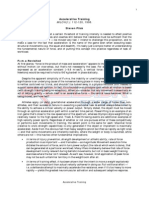Plyometrics
Plyometrics
Uploaded by
api-286283844Copyright:
Available Formats
Plyometrics
Plyometrics
Uploaded by
api-286283844Original Title
Copyright
Available Formats
Share this document
Did you find this document useful?
Is this content inappropriate?
Copyright:
Available Formats
Plyometrics
Plyometrics
Uploaded by
api-286283844Copyright:
Available Formats
ASPH05
Utilising plyometric training: Training adaptations and
considerations.
Plyometric training is commonly portrayed as that standard procedure in
training muscular power within upper and lower body limbs and improves
athletic performance (Markovic and Jukic, 2007). From a physiological
point of view Chu et al. (1999) claims that the aim behind plyometrics is
to convert resistance applied to an eccentric muscular contraction into an
equal or greater concentric contraction, often referred to as the stretchshortening cycle. More specifically, plyometric training is believed to
enhance power and speed in conjunction with reaction time similar to the
characteristics of a competitive sporting situation (Inci Karadenizli, 2013).
Similarly Ebben (2007) stated that plyometric exercise can be classed as
jumping, bounding or throwing exercises which train fast-twitch muscle
fibres as well as the nerves and reflexes which activate them.
Implementing the concepts behind plyometrics into practical use
considers factors such as environment (sand, grass or aquatic),
combination training and training intensity all of which will be explored
throughout this article. Common plyometric exercise techniques mainly
consist of a jumping or explosive nature such as standing jumps, depth
jumps, bounding, throwing and pushing (Chu, 1999) all of which can be
administered bilaterally as well as unilaterally.
Guidelines behind plyometric training implementation should consider
frequency, volume, and intensity and rest periods to ensure effective
training adaptations. The general recommendation for frequency of
plyometric training programmes is two to three sessions per week, but
this should consider factors such as fatigue and interference of other
formats of training (aerobic) when designing a programme (Ebben, 2007).
In terms of volume, Ebben (2007) stated that sets should consist of a
maximum of ten repetitions but lower repetitions with higher intensity is
often favoured to encourage the training of power. Volume considerations
also include foot contacts per session and it is thought that athletes
beginning in plyometric training should perform at least 80 to as many as
Taylor Cornish 20044127
Page 1
ASPH05
100 foot contacts per session, obviously considering intensity within this
as well with more complex exercises being more energy expending than
others (Ebben, 2007). Rest periods are calculated by multiplying the set
length from anywhere between five and ten times depending on intensity
and level of ability. The intensity of plyometric exercises mostly relates to
exercise variation and progression such as bilateral to unilateral
progression, the increase of box height, exercise performed with added
weight and the inclusion of overhead targets are ways to increase exercise
intensity (Ebben, 2007).
The execution of plyometric training in different environments provides
different responses to the joints and muscles the main environmental
comparisons being between firm surfaces and aquatic or sand based
environments. Miller et al. (2002) propose that the weight bearing status
of an athlete reduces when in water, chest deep water creating 30-40%
and waist deep water 47-60% of total body weight respectively. Taking this
into consideration Miller et al. (2002) stated that this reduced weight
status subsequently reduces joint loading making aquatic based
plyometrics appropriate for pre-land based plyometrics work as well as a
rehabilitation technique for joint and muscle injuries. The components of
aquatic based plyometrics can also be considered as a progressive stage
of plyometrics due to surface, profile and wave drag providing increased
resistance to explosive movements performed in water submersion.
Despite these suggestions Stemm and Jacobson (2007) conducted landbased versus water-based plyometric training and found that there was no
difference in strength gains between the two environments, but did
highlight the reduction of muscle soreness and signs of reduced injury
risk. When comparing sand-based plyometrics to firm surface Impellizzeri
et al. (2008) found similarities to the aquatic environment in that jumping
exercises induced less muscle damage than firm surface exercise. Whilst
also considering this surface for rehabilitation purposes Impellizzeri et al.
(2008) proposed its inclusion within a pre-season training schedule to limit
overuse injury risk of a firm surface. In spite of this it was also found that
sand-based plyometrics resulted in the loss elastic energy use during the
Taylor Cornish 20044127
Page 2
ASPH05
landing phase as a result of the surface (Impellizzeri et al., 2008) reducing
the power related benefits and competitive exercise similarities.
Combination training is another plyometric training approach which
involves the grouping of a strength training exercise with a
biomechanically similar plyometric exercise often labelled a complex
group (Alemdarolu et al., 2013). This approach is often taken by coaches
to develop power as well as improvements in vertical jump height, leg
strength, joint awareness and proprioception (Miller et al., 2002). Current
research generally highlights that complex group application is a more
effective method for improving power when compared to conventional
programmes. Reviewing the literature Alemdarolu et al. (2013) reported
that complex training is also an effective measure for muscular
performance improvements, linear power in particular. Although most
studies relate to lower limb it was also reported that rotator cuff exercises
saw the largest improvements in power through combination training.
Conducting their own study Alemdarolu et al. (2013) examined the
effects of combining plyometric and resistance training during the same
session upon squat jump (SJ) and countermovement jump (CMJ),
concluding that combination training increases both SJ and CMJ
performance more than conventional training.
Plyometric training is characteristically known for improving power
through explosive activity through the conversion of eccentric to
concentration contraction known as the stretch-shortening cycle.
Enhanced plyometric training results can be achieved through adaptations
to a conventional plyometric session by considering the effect of intensity,
environment and combination training. Intensity progressions such as
height, weight and overhead reaching are claimed to have enhance
vertical jump and lower limb power outcomes. Consideration to volume of
foot contacts per session should also be taken into account to make
training specific and safe (Ebben, 2007). The choice of environment can
play a role of the outcome of plyometric training especially in relation to
joint loading as sand-based and aquatic-based environments display
Taylor Cornish 20044127
Page 3
ASPH05
reduced joint loading as consideration for rehabilitation and pre-season
programme in relation to injury. However the environment should also be
considered for a plyometric progression due to the increased resistance of
movements performed in water submersion (Miller et al., 2002). Finally
combination training should be considered to enhance the improvement
of power especially when considering linear power and SJ exercises as
conventional programmes show reduced levels of improvement than
those achieved from plyometrics combined with resistance training
(Alemdarolu et al., 2013).
Reference List
Alemdaroglu, U., Dundar, U., Koklu, Y., Asci, A. and Findikoglu, G. (2013)
The effect of exercise order incorporating plyometric and resistance
training on isokinetic leg strength and vertical jump performance: A
comparative study. Isokinetics and Exercise Science. Vol. 21: 211-217.
Chu, D. (1999) Plyometrics in Sports Injury Rehabilitation and
Training. Athletic Therapy Today. Vol. 4, No. 3: 7-11.
Ebben, W. (2007) Practical Guidelines for Plyometric Intensity. NSCA's
Performance Training Journal. Vol. 6, No. 5: 12-16.
Impellizzeri, F., Rampinini, E., Castagna, C., Martino, F., Fiorini, S. and
Wisloff, U. (2008) Effect of plyometric training on sand versus grass on
muscle soreness and jumping and sprinting ability in soccer
players.. British journal of sports medicine. Vol. 42: 42-46.
Inci Karadenizli, Z. (2013) The effects of plyometric training on selected
physical and motorical characteristics of the handball
players. International Journal of Academic Research. Vol. 5, No. 4: 184188.
Taylor Cornish 20044127
Page 4
ASPH05
Markovic, G., Jukic, I., Milanovic, D. and Metikos, D. (2007) Effects of sprint
and plyometric training on muscle function and athletic performance. The
Journal of Strength & Conditioning Research. Vol. 21, No. 2: 543-549.
Miller, M., Berry, D., Bullard, S. and Gilders, R. (2002) Comparisons of
Land-Based and Aquatic-Based Plyometric Programs During an 8-Week
Training Period. Journal of Sports Rehabilitation. Vol. 11, No. 4: 268-283.
Stemm, J. and Jacobson, B. (2007) Comparison of land-and aquatic-based
plyometric training on vertical jump performance. The Journal of Strength
& Conditioning Research. Vol. 21, No. 2: 568-571.
Taylor Cornish 20044127
Page 5
You might also like
- TRAINING FOR GOLD: The plan that made Daniel Ståhl Olympic ChampionFrom EverandTRAINING FOR GOLD: The plan that made Daniel Ståhl Olympic ChampionNo ratings yet
- Treatment of Cardiac Arrest in The Hyperbaric Environment - Key Steps On The Sequence of Care - Case ReportsNo ratings yetTreatment of Cardiac Arrest in The Hyperbaric Environment - Key Steps On The Sequence of Care - Case Reports8 pages
- When Graduation’s Over, Learning Begins: Lessons for STEM Students and ProfessionalsFrom EverandWhen Graduation’s Over, Learning Begins: Lessons for STEM Students and ProfessionalsNo ratings yet
- In-Season Strength and Power Training For Professional Male Team Handball PlayersNo ratings yetIn-Season Strength and Power Training For Professional Male Team Handball Players8 pages
- Book of Programmes for the Team Sport Athlete; Size & StrengthFrom EverandBook of Programmes for the Team Sport Athlete; Size & StrengthNo ratings yet
- Basic Flag Fundamentals: I. Reference PointsNo ratings yetBasic Flag Fundamentals: I. Reference Points8 pages
- Combined Strength and Endurance Training in Competitive SwimmersNo ratings yetCombined Strength and Endurance Training in Competitive Swimmers10 pages
- Could The Deep Squat Jump Predict Weight PDFNo ratings yetCould The Deep Squat Jump Predict Weight PDF6 pages
- Modified Daily Undulating Periodization PDFNo ratings yetModified Daily Undulating Periodization PDF8 pages
- The Effects of Eccentric Versus Concentric Resistance Training On Muscle Strength and Mass in Healthy Adults: A Systematic Review With Meta-AnalysisNo ratings yetThe Effects of Eccentric Versus Concentric Resistance Training On Muscle Strength and Mass in Healthy Adults: A Systematic Review With Meta-Analysis14 pages
- Combined Strength and Power Training in High-Level Amateur FootballNo ratings yetCombined Strength and Power Training in High-Level Amateur Football9 pages
- 2016 Nsca The Effectiveness of Prilepin S Chart For Powerlifting Strength Improvements in Resistance Trained MalesNo ratings yet2016 Nsca The Effectiveness of Prilepin S Chart For Powerlifting Strength Improvements in Resistance Trained Males1 page
- Sports Speed 3rd Edition by George Dintiman ANo ratings yetSports Speed 3rd Edition by George Dintiman A2 pages
- Agonist-Antagonist Paired Set Resistance Training. A Brief Review - Robbins Et Al. 2010No ratings yetAgonist-Antagonist Paired Set Resistance Training. A Brief Review - Robbins Et Al. 201010 pages
- Plyometric Method: Vocational Sports Coaching UnesaNo ratings yetPlyometric Method: Vocational Sports Coaching Unesa9 pages
- 1996 - Biomechanics of The Snatch Towards Higher Training EfficiencyNo ratings yet1996 - Biomechanics of The Snatch Towards Higher Training Efficiency13 pages
- The Science of Strength Reflections On The.31No ratings yetThe Science of Strength Reflections On The.3114 pages
- Periodized Strength Training A Critical Review PDFNo ratings yetPeriodized Strength Training A Critical Review PDF8 pages
- Elements of Fitness: Siff and Verkhoshansky (2009)No ratings yetElements of Fitness: Siff and Verkhoshansky (2009)8 pages
- Block 2 Isometric Above 80 Single Leg SquatNo ratings yetBlock 2 Isometric Above 80 Single Leg Squat4 pages
- Joe DeFranco - Ten Training Myths ExposedNo ratings yetJoe DeFranco - Ten Training Myths Exposed8 pages
- The Fabulous 15 Top 15 Exercises For Higher Vertical Jumps - DeFranco's TrainingNo ratings yetThe Fabulous 15 Top 15 Exercises For Higher Vertical Jumps - DeFranco's Training6 pages
- Technique, Variation, and Progression of The Rear-Foot-Elevated Split SquatNo ratings yetTechnique, Variation, and Progression of The Rear-Foot-Elevated Split Squat5 pages
- Using Velocity in The Weight Room Dr. Daniel Baker PDFNo ratings yetUsing Velocity in The Weight Room Dr. Daniel Baker PDF20 pages
- Book 3: Fitness Analysis for Sport: Academy of Excellence for Coaching of Fitness DrillsFrom EverandBook 3: Fitness Analysis for Sport: Academy of Excellence for Coaching of Fitness DrillsNo ratings yet
- Greg Nuckols High Frequency Template (Exact)No ratings yetGreg Nuckols High Frequency Template (Exact)7 pages
- Uana 2019 Preliminary Summons v2 Jan 2019 - 076679 2No ratings yetUana 2019 Preliminary Summons v2 Jan 2019 - 076679 210 pages
- ENGLISH IV - STUDENT - S TEXTBOOK Ultima VersionNo ratings yetENGLISH IV - STUDENT - S TEXTBOOK Ultima Version84 pages
- Detroit Lakes Jaycees Water Carnival Schedule 2023No ratings yetDetroit Lakes Jaycees Water Carnival Schedule 20231 page
- Arrival of The International Team of English Boxing in Spain in 1911: Boxing Bans and Clashes Over Bullfighting, Regeneration and EuropeNo ratings yetArrival of The International Team of English Boxing in Spain in 1911: Boxing Bans and Clashes Over Bullfighting, Regeneration and Europe26 pages
- Nadia Comaneci - Braun, Thomas, 1944 - 1No ratings yetNadia Comaneci - Braun, Thomas, 1944 - 140 pages
- Physical Education Investigatory Project On Athletics60% (5)Physical Education Investigatory Project On Athletics30 pages
- Anterior Cruciate Ligament Injuries in Soccer Players:: Amit Bandyopadhyay and Shazlin ShaharudinNo ratings yetAnterior Cruciate Ligament Injuries in Soccer Players:: Amit Bandyopadhyay and Shazlin Shaharudin15 pages
- 11 Feb 2017 - Combining & Improve Passing For Penetration - Sampling Stage Session by Paul Bugeja - UEFA Elite Youth A Diploma Course PDF100% (1)11 Feb 2017 - Combining & Improve Passing For Penetration - Sampling Stage Session by Paul Bugeja - UEFA Elite Youth A Diploma Course PDF2 pages
- TRAINING FOR GOLD: The plan that made Daniel Ståhl Olympic ChampionFrom EverandTRAINING FOR GOLD: The plan that made Daniel Ståhl Olympic Champion
- Treatment of Cardiac Arrest in The Hyperbaric Environment - Key Steps On The Sequence of Care - Case ReportsTreatment of Cardiac Arrest in The Hyperbaric Environment - Key Steps On The Sequence of Care - Case Reports
- When Graduation’s Over, Learning Begins: Lessons for STEM Students and ProfessionalsFrom EverandWhen Graduation’s Over, Learning Begins: Lessons for STEM Students and Professionals
- In-Season Strength and Power Training For Professional Male Team Handball PlayersIn-Season Strength and Power Training For Professional Male Team Handball Players
- Book of Programmes for the Team Sport Athlete; Size & StrengthFrom EverandBook of Programmes for the Team Sport Athlete; Size & Strength
- The Ultimate Guide to Weight Training for Baseball & SoftballFrom EverandThe Ultimate Guide to Weight Training for Baseball & Softball
- Combined Strength and Endurance Training in Competitive SwimmersCombined Strength and Endurance Training in Competitive Swimmers
- The Effects of Eccentric Versus Concentric Resistance Training On Muscle Strength and Mass in Healthy Adults: A Systematic Review With Meta-AnalysisThe Effects of Eccentric Versus Concentric Resistance Training On Muscle Strength and Mass in Healthy Adults: A Systematic Review With Meta-Analysis
- Combined Strength and Power Training in High-Level Amateur FootballCombined Strength and Power Training in High-Level Amateur Football
- 2016 Nsca The Effectiveness of Prilepin S Chart For Powerlifting Strength Improvements in Resistance Trained Males2016 Nsca The Effectiveness of Prilepin S Chart For Powerlifting Strength Improvements in Resistance Trained Males
- Agonist-Antagonist Paired Set Resistance Training. A Brief Review - Robbins Et Al. 2010Agonist-Antagonist Paired Set Resistance Training. A Brief Review - Robbins Et Al. 2010
- Plyometric Method: Vocational Sports Coaching UnesaPlyometric Method: Vocational Sports Coaching Unesa
- 1996 - Biomechanics of The Snatch Towards Higher Training Efficiency1996 - Biomechanics of The Snatch Towards Higher Training Efficiency
- Periodized Strength Training A Critical Review PDFPeriodized Strength Training A Critical Review PDF
- Elements of Fitness: Siff and Verkhoshansky (2009)Elements of Fitness: Siff and Verkhoshansky (2009)
- The Fabulous 15 Top 15 Exercises For Higher Vertical Jumps - DeFranco's TrainingThe Fabulous 15 Top 15 Exercises For Higher Vertical Jumps - DeFranco's Training
- Technique, Variation, and Progression of The Rear-Foot-Elevated Split SquatTechnique, Variation, and Progression of The Rear-Foot-Elevated Split Squat
- Using Velocity in The Weight Room Dr. Daniel Baker PDFUsing Velocity in The Weight Room Dr. Daniel Baker PDF
- Girls and Sport: Female Athlete Triad SimplifiedFrom EverandGirls and Sport: Female Athlete Triad Simplified
- Book 3: Fitness Analysis for Sport: Academy of Excellence for Coaching of Fitness DrillsFrom EverandBook 3: Fitness Analysis for Sport: Academy of Excellence for Coaching of Fitness Drills
- Uana 2019 Preliminary Summons v2 Jan 2019 - 076679 2Uana 2019 Preliminary Summons v2 Jan 2019 - 076679 2
- Detroit Lakes Jaycees Water Carnival Schedule 2023Detroit Lakes Jaycees Water Carnival Schedule 2023
- Arrival of The International Team of English Boxing in Spain in 1911: Boxing Bans and Clashes Over Bullfighting, Regeneration and EuropeArrival of The International Team of English Boxing in Spain in 1911: Boxing Bans and Clashes Over Bullfighting, Regeneration and Europe
- Physical Education Investigatory Project On AthleticsPhysical Education Investigatory Project On Athletics
- Anterior Cruciate Ligament Injuries in Soccer Players:: Amit Bandyopadhyay and Shazlin ShaharudinAnterior Cruciate Ligament Injuries in Soccer Players:: Amit Bandyopadhyay and Shazlin Shaharudin
- 11 Feb 2017 - Combining & Improve Passing For Penetration - Sampling Stage Session by Paul Bugeja - UEFA Elite Youth A Diploma Course PDF11 Feb 2017 - Combining & Improve Passing For Penetration - Sampling Stage Session by Paul Bugeja - UEFA Elite Youth A Diploma Course PDF

























































































